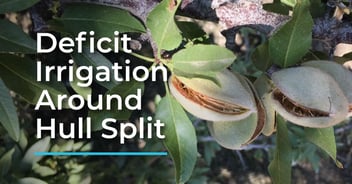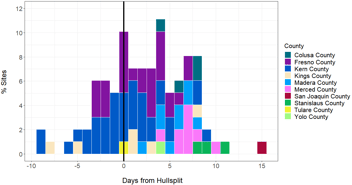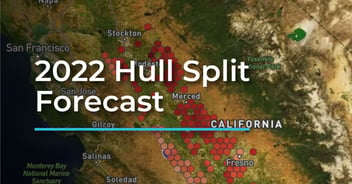Navel Orangeworm Management with Nutmeal Lures + 2023 Pollenizer Update
We're excited to announce the launch of our Managing Navel Orangeworm Video Series which will be updated throughout the 2023 season to provide practical pest management tips alongside regional navel orangeworm trap activity and degree day updates.
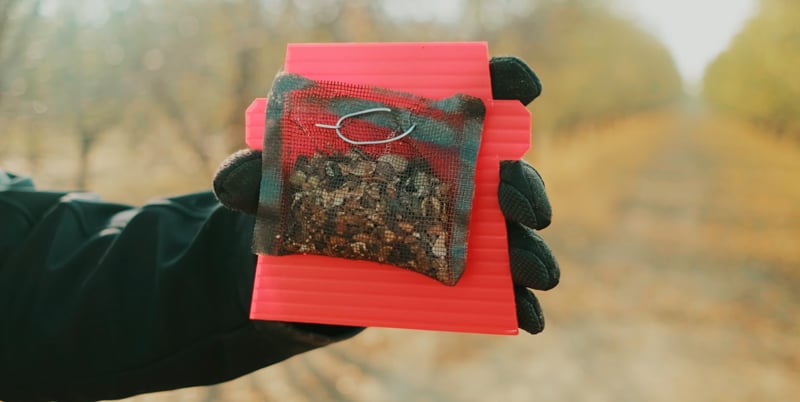
These videos are designed to help Semios users learn how to leverage the new trap data they'll be seeing this year with our switch to nutmeal lures in Semios navel orangeworm traps. They'll also be a useful resource for growers and PCAs looking to make more informed navel orangeworm pest management decisions with the help of better data.
Who is this video series for?
- Semios users managing navel orangeworm in almonds or pistachios
- PCAs or growers looking for navel orangeworm management tips
- Anyone looking for updates on California regional navel orangeworm insights and trends
Jump to a section:
Managing Navel Orangeworm Video Series
1. Introduction to Nutmeal Lures
Video overview:
Managing navel orangeworm under mating disruption can be difficult if you don't have the right data.
In this video, you'll learn how different lures used in navel orangeworm traps can affect the usefulness of the trap data and why we've decided to switch over to using nutmeal lures.
You'll see the benefits of nutmeal lures in action after walking through an example of real navel orangeworm trap data collected on a ranch in California, and how it can be used to inform pest management decisions.
You'll then gain some tips on how to prepare for the start of the navel orangeworm season to set yourself up for success.
2. Mid-season Regional Navel Orangeworm Update (May 30, 2023)
Video overview:
In our first regional update, we’re providing novel insights from our California-wide navel orangeworm monitoring network of over 1,000 nutmeal lure camera traps. The data and insights we share in this video are meant to help guide your on-farm navel orangeworm management decisions, including setting your biofix.
Biofix is an identifiable point in the navel orangeworm’s life cycle at which we can begin degree-day accumulations (UCANR). Setting a biofix can help you better predict upcoming navel orangeworm flights and plan hull split sprays.
We start off with a look at regional navel orangeworm data related to trap activity. Here are our average year-to-date trap catches for the 2023 season, up to May 26th.
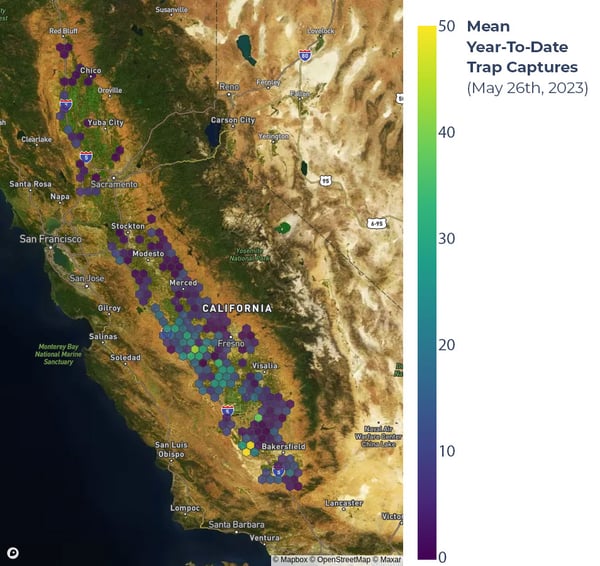
A map of California showing the average year-to-date NOW trap catches for the 2023 season up to May 26th. The light yellow and green areas highlight regions with higher trap catches, while the dark blue and purple areas have fewer or no trap catches on average.
In the video, we walk through examples of how you can use both farm-level and regional-level data to help guide your navel orangeworm management decisions.
💡 This year, Semios customers can request a custom navel orangeworm trap capture report for their ranch that compares their farm’s trap captures to average trap captures at the regional and state-wide levels. This is a brand-new feature being tested this season. We’re excited to offer Semios customers a free sneak peek.
Next, we discuss how the weather has been influencing navel orangeworm behavior this year, and share some regional temperature and degree day progression insights.
-Update-7-23-screenshot-cropped.jpg?width=500&height=596&name=2023-Mid-Season-California-Navel-Orangeworm-(NOW)-Update-7-23-screenshot-cropped.jpg)
A map of California showing the difference in navel orangeworm degree-day accumulation between the 2023 and 2022 seasons. On average, all regions are behind in degree-day accumulation compared to the previous year.
Overall, the start of the 2023 season has been much cooler than in recent years, leading to fewer degree days being accumulated so far. However, this has varied by farm and by region, so we recommend checking your on-farm weather and trap capture data to see how this will impact you.
💡 Semios customers can check their site-level trap capture, degree-day accumulation, and historical weather data on the Semios crop management platform: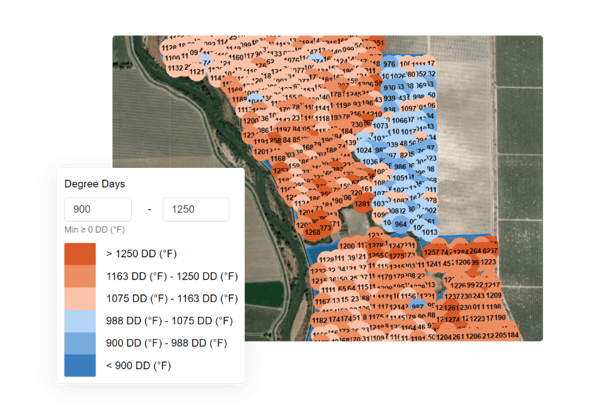
- Navel orangeworm dashboard for trap capture and degree-day accumulation data
- Weather page to view your historical temperature data
3. Hull Split Forecast & Navel Orangeworm Update (June 29, 2023)
Video overview:
In this video, we’re focusing on hull split, the patterns of navel orangeworm flight that occur during hull split, and how this could affect your management.
Due to the unique climatic circumstances of 2023, weather conditions caused a delay in bloom and a subsequent delay in hull split across the valley. In the video, we briefly discuss some of the patterns we're seeing.
You can see the forecasted delay in hull split dates in the map below which shows the 1% hull split forecast for the year by region (based on Semios in-canopy sensors).

A map of California showing the forecasted 1% hull split date for the 2023 season, based on data from Semios in-canopy sensors. The dark blue areas highlight regions that are forecasted to have a mid to late July 1% hull split date, while the light blue areas are forecasted to experience 1% hull split in early July.
In contrast, you can see how much earlier hull split occurred in 2022 based on this map below, which shows the difference between forecasted 1% hull split dates in 2023 compared to last year.
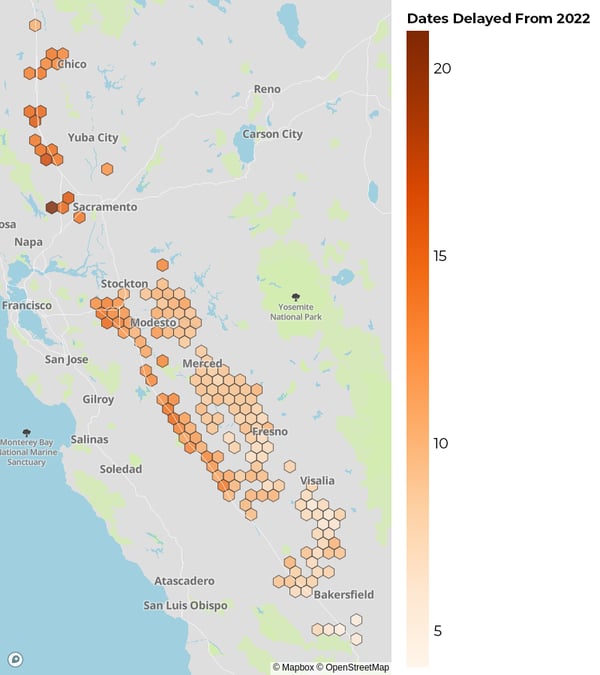
A map of California highlighting the extent of the delay in hull split forecasted for this year. The orange areas highlight regions that are forecasted to be around 2-3 weeks behind, while the light orange areas are forecasted to be around 1-2 weeks behind.
While these regional insights are helpful in understanding the overall trends we're seeing this year, the best way to find out how this affects you is through the use of on-farm data. In the video, we'll explore several Semios tools that can help you understand your orchard’s unique conditions and how you can effectively plan and evaluate your navel orangeworm management program.
💡 Semios customers can check their custom hull split forecast on the Semios crop management platform:
- View your hull split forecast by on-farm weather stations for different almond varieties.
- View your per-acre hull split forecast to help identify warmer areas of your farm where almonds may be splitting earlier. This is particularly helpful for planning logistics on larger ranches.
- For a more accurate forecast, enter your full bloom dates on the hull split dashboard
Example of a California almond orchard per acre hull split forecast heatmap
Click for more information on Semios Integrated Pest Management solutions.
4. Pollenizer Hull Split Forecast & Navel Orangeworm Update (August 17, 2023)
Video overview:
In this video, we’re discussing forecasted pollenizer hull split dates and the upcoming 3rd navel orangeworm flight.
As we talked about in the previous update, the cool and wet spring that delayed bloom also delayed hull split. This year, we saw Nonpareil almond hull split being delayed by 1-3 weeks. Pollenizer varieties are also expecting a later hull split.
Here are our hull split forecast dates for Monterey almonds:
- South of Fresno: Week of August 21
- Modesto - Merced: Week of August 28
- North of Modesto: Late August to 1st week of September
Since Monterey is a late variety, other pollenizer varieties are expected to split at an earlier time.
💡 For more accurate hull split dates, Semios customers can check their custom hull split forecast by almond variety on the Semios crop management platform.
When it comes to navel orangeworm management, hull split is the most critical time in the season.
In the video, we walk through an example of how a farm's on-site navel orangeworm (NOW) trap data from employing nutmeal lures can be used to guide your management decisions. We introduce the concept of a pre-hull split NOW cohort and a post-hull split NOW cohort since both groups need to be managed differently. Carefully identifying and considering these two cohorts is a valuable approach when planning and evaluating your NOW management program.
Subscribe for Email Updates
Don't miss our next update! Fill out the form below to be notified when a new video in our Managing Navel Orangeworm series is released:



